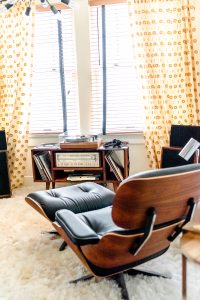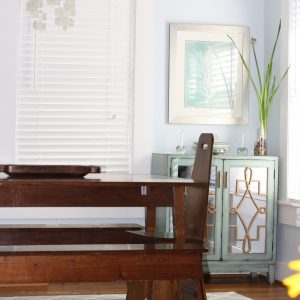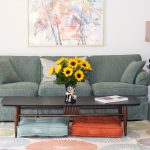Top Five Interior Decorating Tips
Alongside with decluttering and “straight-up Feng Shui,” for a space to really find its potential, interior decorating usually needs to come in to play.
It’s a great honor (and a lot of fun) to help clients bring out their personal expression in their space (sofas! pillows! artwork! rugs! tiles! countertops! oh my!) so they can truly enjoy it.
In the spirit of guiding and inspiring you to make changes in your home or office, here are my
TOP FIVE INTERIOR DECORATING TIPS:
- Defining the room. I like to have a somewhat lengthy discussions on how the client sees the room functioning. Sometimes it’s obvious, such as dining or watching television, but I do like to get a feel for the lifestyle the client and his or her family in order to figure out what a room should be for them! Your home can be utilized to create the life you are looking for and wanting, and when you get intentional about function, it’s a great starting point!

This client’s kitchen had the perfect corner for a large dining area for the whole family, plus some.
Questions to ask to start:
- Who will be spending time in here?
- What will those people be doing, ideally?
- Will it be mostly for personal use or for entertaining or both?
- If entertaining is an aspect of this room, how often would you like to entertain and in what ways?
- Are you needing a space that is more inspirational or invigorating or more restful and quiet?
- What have been the problems with this room (or a room like it) been in the past?
- Assigning a “jumping-off piece” + figuring out what stays and what goes. While I’ve done rooms from scratch, a lot of times clients need some basic updating and rearranging and an idea on what stays and goes. What’s nice when you start redecorating a room is to find an item that can be used as a jumping off point. It can be the bed, or a grandmother’s chaise, a piece of artwork, or even a piece of fabric! The important thing is that what stays, is honored, and it may just be the inspiration that the entire room revolves around!
On the other hand, if there are items that don’t “spark joy,” (thanks, Marie Kondo), then one should seriously think about letting them go because they could clog up the entire design process! A gentle reminder that “everything has a home – even if it is in someone else’s home” and “one person’s trash is another’s treasure” can help with this process as far as donating or selling or giving away goes.
3. Choosing a color palette. How I love a deck of Pantone cards! On occasion, I’ll lay out those cards in front of a client, simply so they can just pick at random to see where their taste lie and to remind them that this is a fun and creative process, not to be taken too seriously! This is not the only way to figure out a palette; sometimes the “key piece” defines the color scheme. I also remember famous designer, Emily Henderson, looking through a client’s clothes to see what colors they tend towards and like. Very nice idea!
Regardless, deciding a range of colors for each room can bring focus, clarity, and excitement into the project. I’ve worked with rooms that were primarily neutrals, in bone, deep taupes, and off blacks with gold accents, as well as rooms that burst with color, including magentas, turquoises, yellows, and more. The key is to find a few core colors and stick to them, using neutrals to balance things out when necessary. One can flip through a paint deck or choose a great fabric or simply go on-line and look through Pinterest to get ideas for color schemes.
Again, it’s important to keep it playful! That joy will influence the project and the final result immensely.
- Measuring thrice. I’m neurotic when it comes to measuring mostly because if I mess that up, it’d be a real pain to fix, and I’m a preventive type of person. I love to get a floor plan to scale and play with furniture ideas at their exact measurements in order to find the best fit for the space. I’m a big fan of blue tape on the floors to mark out the dimensions so the client can feel what it would be like to have something that size in that room. It works! And it’s worth it! Especially for big ticket and big size items! The extra pre-paving is worth it!
5. Creating cohesion and adding personal touches. Once you’ve placed and decided on key larger pieces, it’s important to keep going! Things like drapes or rugs or lamps or side tables or even decorative items such as candles, plants, or books can warm up a space immensely. I especially love to implement and “honor” items special to the client. Personal photos and souvenirs from vacations and family heirlooms (if liked!) will add tremendous personality and individuality to the space.
Consider it like this: Imagine that a stranger came to your home when no one was there. You do not want them to leave feeling like they’ve walked through a West Elm or Restoration Hardware (or any) show room! You do want them to leave feeling like they gotten to know you and those who live there.
And if you’re really doing it right, they’ll feel so great in the space, they won’t want to leave!

While the chair was the jumping off piece to this midcentury-modern “music listening” room, the record player and speakers were sentimental to the client. Add some fun custom drapes, a shag rug, and a sputnik light fixture, and walah!
To see if you and Katie are a fit for an interior decorating session, call her at 205.983.0888.






